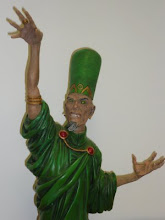 Pitch black dystopian science fiction, stripped down to the barest essentials for the story and illuminated by astonishing art. In the shattered ruins of a future Earth two groups fight for dominance, the Commune and the Council both struggling to capture the market for their competing mix of drugs and salvation. Ex-lovers, Emil and Lisa are employed on each side of the struggle. Emil racked by guilt at having sols Lisa to organ harvesters to pay for drugs works for the Commune while Lisa, now known as Crash works for the council, to pay for restored organs. Her hearing and speech were not restored and remain scrambled, she can communicate freely only with a doll, Lara.
Pitch black dystopian science fiction, stripped down to the barest essentials for the story and illuminated by astonishing art. In the shattered ruins of a future Earth two groups fight for dominance, the Commune and the Council both struggling to capture the market for their competing mix of drugs and salvation. Ex-lovers, Emil and Lisa are employed on each side of the struggle. Emil racked by guilt at having sols Lisa to organ harvesters to pay for drugs works for the Commune while Lisa, now known as Crash works for the council, to pay for restored organs. Her hearing and speech were not restored and remain scrambled, she can communicate freely only with a doll, Lara.The longest story in the book concerns the search for a woman, a mutant who can sense future events. Such mutants are vital to the plans of Marshal Saki who rules both the Commune and the Council from his base on the moon. He uses the pre-cogs to know what his enemies are planning on and to stop them first, with the last one in his power dying the search for a replacement is urgent. The search pulls in both Emil and Lisa as the woman is hunted by combined forces of both the Commune and the Council. The best story in the book is a short episode where Lisa's doll is stolen by a virtual walking skeleton for an astonishing reason and in a clever and bleakly humorous episode Lisa's deafness is used as a weapon against a significant threat to the existing structure.
The stories are as bare bones as possible, sometimes there is extra information provided to make sense of the actions, Emil explains about his relationship with Lisa because the it will become important a little later. Otherwise there is the minimal amount of information provided, just enough to set the scene and give enough depth to the context so the cast are not actually moving through a vacuum. The cast of grotesques that race, rage and kill and sometimes rest are get all the attention, they are given a surprising degree of depth while all operating with very narrow emotional ranges. Carlos Trillo has managed to give them more than enough humanity to really pull in the reader and give the ferocious melodrama a considerable punch.
Eduardo Risso's luminous black and while art is breathtaking. It is genuinely black and white, there is no shading in the art, the definition and detail is provided only by direct contrast. This extreme approach is perfectly suited to the extremity of the story and the context, this is the end of the world, down in the ruins there is no room left for anything except the most explicit actions and motives. The cast are a range of astonishing grotesques, some human males and absurdly beautiful women who are more frequently undressed than not. Eduardo Risso avoids the kind of sleazy coyness epidemic in comics by simply having half naked women because he wants to. This straightforward approach means that the female cast are not undermined as characters by having breasts, they are very much part of the character rather than being the character.
Using melodrama to shelter subtle points and unexpected character depth this is a great comic.


No comments:
Post a Comment